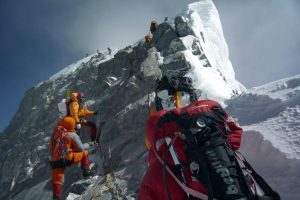The “Man Killer” that is Everest
May 29, 2019One of South Carolina’s top mountaineers discusses climbing perils
By W. Thomas Smith Jr.
South Carolina’s own Tom Mullikin is intimately familiar with Mount Everest. No, the Camden-based global expedition leader has yet to achieve the summit of the 29,000-plus-ft. “man killer.” But he has worked the mountain during a conditioning push, spending time earlier this year at-and-around Everest’s high-altitude base camp. And he has successful climbs up four of the world’s seven great summits, having several times negotiated daunting portions of all.
Mullikin’s experience as a mountaineer – dubbed a “National Geographic Expert” by NatGeo – is matched only by his SCUBA dives in all of the earth’s oceans including dangerous ice dives in the Arctic and Antarctic Oceans: Unforgiving environs all where years of training, physical conditioning, proper equipment, and attention to every single detail can be the difference between surviving and not.
Like other adventurers with his level of mountain-climbing experience, Mullikin knows first-hand what the onset of altitude sickness feels like and what extreme cold and altitude can do to both the body and the mind.
We sat down with Mullikin to discuss some of the perils of climbing, particularly Everest, in the wake of at least 11 lives lost there this year.
W. THOMAS SMITH JR: British mountaineer Robin Haynes Fisher, an experienced climber, died while he was descending Everest. He was literally on the way down, but still in the so-called death zone. What exactly is this death zone?
TOM MULLIKIN: The death zone is that altitude roughly above about 26,000 feet where it is generally believed that a human-being can no longer become acclimated to the extreme cold and altitude. Keep in mind, the summit is more than 3,000 feet above that 26,000 mark. So, you pretty much have the final 3,000 feet of the ascent being the death zone, then you have to consider the 3,000 feet to ascend from the summit, which is every bit as dangerous. Many of the Everest fatalities, like Fisher’s, have been after they had reached the summit and were working their way back down.
The negative impacts of high altitude on the human body are very real. Without getting too technical here, remember that above 7,000 feet, the body begins to have difficulty with the saturation of oxygen in the blood. The body is able to adapt in the short term and with medication can adapt in part in the long term. At sea level, the air contains about 21 percent oxygen, but when you get to altitudes above 12,000 feet, the oxygen levels are about 40 percent lower. And then when you get into the so-called ‘death zone’ – above 26,000 – the oxygen is so limited that the cells in your body literally start to die.
And there are frankly many extremely dangerous manifestations of altitude sickness, and they come upon you suddenly even if you are physically fit. You can have a heart attack, stroke, not to mention your judgment becoming impaired, which I have seen result in death. I simply cannot reiterate – and I think the world is now seeing – that this is very dangerous work.
SMITH: Why can’t supplemental oxygen alleviate the problem? If a high-altitude pilot can soar to extreme heights or an astronaut, why not a climber?
MULLIKIN: Several reasons, one of which is that someone – you or someone else – has to carry the supplemental oxygen with them. So, the weight of your equipment is a factor. Also when you climb up into this ‘death zone’ that we’re talking about, the air around you has so little oxygen in it that even with supplementary air tanks – according to one description that I read – you begin to feel like you are “running on a treadmill” and simultaneously “breathing through a straw.” And this is true.
SMITH: What can be done about the climbing queues up Everest which seem to cause deadly bottlenecks up and down the summit?
MULLIKIN: The countries that are controlling the permits need to reduce the number of permits to climb. Period. There are so many climbers attempting to summit Everest today that they are in some instances literally climbing past and over other climbers and their gear. That is extremely dangerous in a situation that is already very dangerous.
SMITH: What is your best advice for someone considering the physical challenges of climbing Everest or any one of the other seven great summits?
MULLIKIN: Three things: First, Go SLOW! Allow your body to acclimatize to the extreme altitude. Never fight the mountain. Never ego your way to the summit. Always listen to what your body is telling you. Oh, yes, and be in the best shape of your life.
Second, NEVER attempt to climb a mountain – any mountain – without a clear plan. And never allow someone to guide you who is not experienced on that mountain.
Third, check with a high-altitude medical professional and TAKE YOUR MEDICATIONS as prescribed. These medications can save your life.
SMITH: What is the media or the non-climbing public missing about these challenging climbs?
MULLIKIN: These climbs are more difficult than most will ever imagine, and they are very dangerous. Anyone climbing mountains only to achieve the summit is a fool in my opinion. A real mountain climber or mountaineer loves the mountain. Period. He or she loves the outdoors and the beautiful environment that the Lord has given us all. And you find that if you are only focused on the summit, you will miss much of the beauty along the way and you may sacrifice your own judgement with fatal results.
Tom Mullikin is the chairman of Global Eco Adventures. Visit GEA at http://globalecoadventures.org/

















